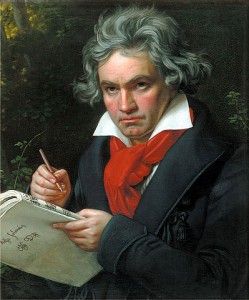
Ode To Joy is the final movement of Beethoven’s Ninth and last Symphony. The German composer was increasingly aware of his declining health and spent seven years working on this symphony, starting the work in 1818 and finishing early in 1824. The symphony is one of the best known works of the Western classical repertoire and is considered one of Beethoven’s masterpieces.
At the time it was a novel idea to use a chorus and solo voices in a symphony, which is why it’s also called the “Choral” symphony. Beethoven, in fact, had serious misgivings about portraying the music’s message with actual words. Even after the premiere, he apparently came very close to replacing all the vocal lines with instrumental ones.
The words, which are sung by four vocal soloists and a chorus, emanate a strong belief in mankind. They were taken from a poem written by German writer Friedrich Schiller in 1785 and revised in 1803, with additions made by Beethoven.
Beethoven was completely deaf when he embarked on this masterpiece, and it’s a tragedy that he never heard a single note of it except inside his head. At the end of the symphony’s first performance the German composer, who had been directing the piece and was consequently facing the orchestra, had to be turned around by the contralto Caroline Unger so that he could see the audience’s ecstatic reaction. Beethoven had been unaware of the tumultuous roars of applause behind him.
via Ode To Joy by Ludwig Van Beethoven Songfacts.
I think Joy is a pretty good word to describe the people in this video.

Brad, you touch me deeply as does this music. The spirit of the music that you feel and share humbles me and makes me realize that with the help of God we can sustain almost anything and still feel joy which is really only the other side of sorrow.
Bless you and your family during this most joyous of seasons.